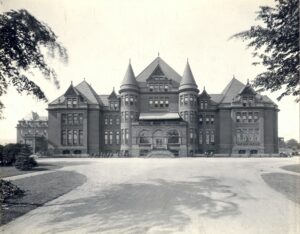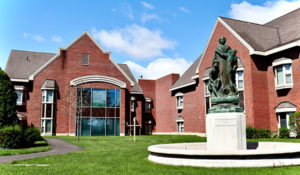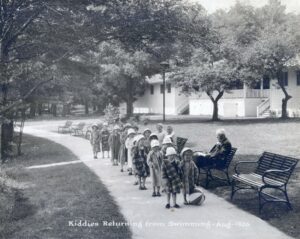130 Years Strong: Promises Made, Promises Kept
A Celebration of Service to Our Community
This year marks an important historical milestone as we celebrate the 130th anniversary of the Masonic Care Community. As legend goes, in 1842 a man by the name of Greenfield Pote, the Grand Tiler of the New York State Masonic Fraternity, laid a silver dollar on the altar of the Grand Lodge Session and asked for the creation of a home for indigent Masons, their wives, and their orphans. One year later, a memorial was presented at Grand Lodge that contained the signatures of one hundred Masons and was accompanied by a sum of $300. The group asked to raise money to do two things—build the Masonic Hall in New York City to house Grand Lodge and Masonic bodies and to establish a home for Masons.
First, the Masonic Hall in New York was built in Manhattan, where it still stands today. The revenue from that building was used to build the Masonic Home and still supports the Masonic Care Community to this day. The gift of one single dollar is a meaningful and strong demonstration of the power of philanthropy.

Masonic Care Community’s Present is Informed by Its Rich Past
Often the question is asked, why Utica, New York? Utica was chosen because it is the geographic center of New York State. We like to call it the Heart of New York. With 130 years of history, volumes could be written about the Masonic Care Community. I will highlight just a few important parts of that history here:
— The Soldiers and Sailors Hospital opened in 1922 and had all the modern facilities, including an operating room, physiotherapy, x-ray, dental rooms and laboratories and 132 beds. The Hospital was built with money left from a Masonic World War I relief fund. The building was converted into a skilled nursing facility in the early 1900s. The Trustees of the Masonic Home and Asylum Fund opted to help us move into the 21st Century of senior care and construction was started on the Health Pavilion in 2000; renovation of the Soldiers and Sailors Hospital was begun. The Health Pavilion is now a 320-bed capacity facility with a household model of care within neighborhood levels to create a real community and a homelike environment versus an institutional type environment.
— In front of the hospital stands a statue of Orville Parker Johnson who was killed in Torcy, France on July 18, 1918. While he was at Harvard College, war was declared in Germany and Orville was active in recruiting men from Harvard as well as the manufacturing towns about Boston. Charles Johnson, his father, was a former Grand Master. There is also a dedication plaque by the statue in honor of all Masons who have served in support of their country.

— One of the most beautiful dedications on campus is the “Spirit of Masonry” statue which depicts a soldier and sailor from World War I unclothed, as they are being protected by the Brotherhood. Dedicated by Grand Master Tompkins in October of 1922, this work of art was created by Most Worshipful Ettor Ferrari who was the Grand Master of the Orient of Italy. The creation of this exceptional statue was made possible by the Lodges of the 10th Manhattan District.
— Originally built in 1928 to house boys on campus, Wiley Hall was named after William “Pop” Wiley, the longest-serving superintendent in MCC’s history, from 1906 to the mid-1940s. Wiley Hall was later converted to senior living. In the 1980s the first independent living apartments opened on the upper floors. Reconstructed in 2007, Wiley Hall now serves as an adult care facility and provides the perfect mix of services and activities to address an individual’s moderate healthcare needs.

— Pop Wiley was also involved in the purchase of Round Lake, the Masonic property in the Adirondack Mountains, and he was responsible for moving education for the children off of campus and into the Utica public schools. Children from the Masonic Home spent summers at Round Lake, which remains relatively unchanged from when it was originally built.
— The Masonic Care Community also has a beautiful Horticultural Center, a unique amenity for a senior care community. Opened in 2019 and championed by former Grand Master, William Sardone, the Center was the former site of the Masonic Home laundry facility. It contains a traditional greenhouse for growing plants and an aeroponics area where lettuce and herbs grow in towers without the use of soil. The Horticultural Center also has a community room and classroom supporting staff, residents, and childcare activities. It also has an outside fire pit and patio. Our bee and honey production programs are part of the activities under the Horticultural Center, including our Bee Apiary Home which houses twelve beehives and donated by Masonic Lodges from around the state.
— The Masonic Home also had a working farm where The Neighborhoods at Acacia Village stand today. Cows, pigs, chickens and turkeys were raised on the farm, produce was grown, and milk, eggs and cheese were produced right here on campus. The farm closed in 1969 as New York state rules and regulations changed.
— Constructed in 1994, The Neighborhoods at Acacia Village began with sixty independent senior living apartments and has now grown to 135 units. To provide additional housing opportunities for elderly seniors, we recently completed the construction of sixteen new independent homes that are separate from our main Lodge building of apartments. Residents of The Neighborhoods at Acacia Village live independently and do not require assisted living services.
— The Scottish Rite Building is the residence for the Grand Master when he visits the Masonic Care Community campus. Originally known as the Scottish Rite Cottage, it was the home for babies that came to the Masonic Home and later used as the home of the school superintendents of the Masonic Home.
— Built in 1923, the former Livingston Museum building was the home for babies. Children as young as four months old lived there. In the
1940s it became the girls’ dormitory. This was the last building to house children on campus. In 2020 the Museum space was converted to offices for MCC’s Home Care Agency.
— Between 1893 and 1982, over 900 children were cared for at the Masonic Home and we continue that tradition today. Our licensed Child Care Center provides affordable, professional childcare to our employees as well as residents of Oneida and surrounding counties. We also offer expanded childcare programming in the summer.

— The Chapel was dedicated in 1893 to Daniel D. Tompkins, the former Vice-President of the United States. Tompkins was also the Grand Master of New York State, and Sovereign Grand Commander of the Scottish Rite Supreme Council Northern Jurisdiction. The Daniel D. Tompkins Chapel is the oldest and most historical building on campus. Here are several of the Chapel’s extraordinary features:
- The Chapel features spectacular Tiffany and Gorham stained glass windows. Masonic Lodges from across NewYork State donated a large number of these windows.
- In the Chapel’s entranceway stands the statue of Silence created by artist Augustus Saint-Gaudens for Grand Lodge. Later this magnificent stone statue was moved from Grand Lodge to the Soldiers and Sailors Hospital for the opening of the Masonic Home, and it was then moved to the Chapel in 1970.
- The Chapel Ceiling Zodiac Light is a spectacular feature and has the signs of the zodiac in the inner circle with the names of the 39 original lodges that sponsored the fixture on the outer circle. Estimated to be the most valuable artistic feature in the Chapel a number of years ago, it was valued at more than $1 million dollars.
- The Chapel organ is one of the last remaining Buhl pipe organs of its type in the state of New York.
Looking Toward Our Future
This summer a beautiful new feature is coming to the Masonic Care Community. A Veterans Memorial Garden is being created to honor the legacy of our American military veterans. Go to this page for more details about how you can join in helping to create this special space for our Military Services in honor of what they have done for our country.
For my fellow Brother Masons who were not able to join us for St. John’s Day: we invite and welcome you to visit the Masonic Care Community and experience what your continued support makes possible. You are upholding a promise that started with a single silver dollar so many years ago. Please join me in celebrating 130 years of the Masonic Care Community.
—Rob Raffle, Executive Director, Masonic Care Community of New York
